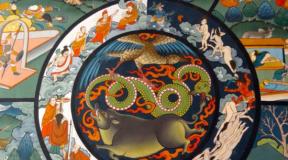How to find the constellation Aquarius. Aquarius constellation and astronomy, astrology and legends
It is difficult to see in the stellar outlines of this constellation a person pouring water from a jug. But you can see a large space spider, spreading its furry legs, which in the spring at dawn begins to climb the sky in the south-eastern part. At the beginning of winter, in the evenings it obediently crawls under the horizon. Aquarius is visible almost all summer and autumn, and is located exactly at the intersection of summer and autumn constellations. For the most part, Aquarius is located in the southern celestial hemisphere and therefore is visible in the northern latitudes of our Motherland. On the star map, it borders on the constellations Capricorn, Southern Pisces, Whale, Pisces, Pegasus, Lesser Horse, Dolphin and Eagle - it has many neighbors.
Finding the constellation Aquarius in the sky is not difficult - on summer nights it is located immediately below the extended and noticeable Pegasus. Our ancient ancestors saw a lot of different things here and therefore there was no single legend about Aquarius. Perhaps this ambiguity gives astrologers today the opportunity to weave to this place on the star chart all sorts of fables about the coming era of Aquarius and the incredible abundance and prosperity accompanying this milestone. In fact, there are no objective prerequisites for this. Aquarius will take the baton of accepting the point of the spring equinox within its borders very, and not soon, according to human ideas. No significant planets begin their long-term positioning in Aquarius (Neptune is already urgently leaving this constellation, and Uranus will soon enter it, but will stay only for a few years, which is in no way comparable to the concept of “Era”; Pluto “goes” to Aquarius for another hundred years , Jupiter will enter the expanses of Aquarius at the beginning of 2010 and will stay there for a year, Saturn could stay for two and a half, but only after ten years).
And yet, what did they see in these stars in the era of star myths?

There are several small tales on this topic. The very first and most logical thing is related to the seasonal factor - it was during the period of the appearance of these stars in the morning dawn that agricultural irrigation work became relevant and “Aquarius” irrigating fields and plantings was very, very useful. Another mention of a certain giant man frantically pouring water from the sky is associated with the so-called “World Flood” present in the annals of various nations, and if the constellation Aquarius owes its name to this natural disaster, it is unlikely that the whole era of this very Aquarius will be useful to us. It's better somehow without her. Later legends tell about a certain young man, very handsome and noble - the son of one of the Greek kings - Tros - his name was Ganymede. Ganymede was called by Zeus to Olympus as a cupbearer (which is why there are persistent rumors that in fact Aquarius pours not water at all from his jug, but wine or even divine nectar!) to serve the gods during regular “high-mountain” feasts and in return, Zeus promised the young man immortality. But jealous Hera even here found reason to suspect her divine spouse of infidelity and demanded that she quickly get rid of the handsome cupbearer. Zeus had to obey this time too. Ganymede was demoted to the constellation, but thereby gained the promised immortality. There were many other fairy tales about Aquarius, but I’m already pretty tired of them and it’s time to move on to the astronomical essence of this constellation.

There are no very bright stars within the boundaries of the constellation Aquarius, but there are many stars of medium brightness from which its branched figure is completely formed. All these star chains begin from the star Zeta Aquarii (it has its own name of Arabic origin - Sadaltager).

Zeta Aquarii, together with three other stars of this constellation (Gamma, Eta and Pi), forms a “Y”-shaped asterism - a visually close group of stars that are actually very far apart in space. And indeed, Zeta is the closest of them - 105 light years away. Gamma and Eta are noticeably further away - 163 and 191 light years. Pi Aquarii is very far away - more than a thousand light years from the Sun and the three previously mentioned stars of this optical cluster. But from here, from Earth, this three-rayed “propeller” looks nice and is a distinctive feature of the constellation Aquarius, by which it can be unmistakably recognized in the sky.

Already a small telescope, but with a very significant magnification, will show us that Zeta Aquarii is a double star (the distance between the components is 2"). This duality is not optical - both stars are connected by gravitational forces and revolve around the center of mass of this system in 361 years.
In the eastern part of the constellation and much to the south there is another characteristic star formation, quite characteristic of Aquarius - the “Frog's Leg” asterism. The “paw” is formed by five dim stars: Phi Aquarius, Chi Aquarius and three stars located in a chain Psi-1, Psi-2, Psi-3 Aquarius. Located in the middle of the asterism, the dark red Chi of Aquarii is an irregular stellar variable with insignificant amplitude, but it is fair to say that at the moment scientists simply do not understand the nature of this star and therefore classify it as one of the many stars that change their brightness in an unpredictable way. At one time I also studied this star, but in Moscow conditions, when the Chi of Aquarius does not rise very high above the horizon, and the number of transparent and clear nights is not enough, I also was not able to somehow advance towards studying the laws by which the Chi of Aquarius changes your shine.

Directly below the red variable there is a double star - Psi-1 Aquarii - its duality can be detected even by the owner of small binoculars, since the distance between the stars is quite large (80"). Very powerful professional telescopes show that in the Psi-1 Aquarius system the forces of universal gravity five stars are connected.Recently, in this complex system of stars, an extrasolar planet was also discovered, orbiting one of the stars and comparable in size to “our” Jupiter.
The constellation Aquarius contains one of the largest globular star clusters. The “star ball” numbered M2 (this is the second object included in the famous catalog of various kinds of comet-like objects by its creator, Charles Monsieur. The first one, as you remember, was included, as you remember, was the “Crab Nebula” in the constellation Taurus) is located at the northern border of Aquarius with the constellation Pegasus. It can be seen even with small binoculars, but only a telescope will help you see it in detail.

At the western border of Aquarius there is another “Star Ball” (M72), but it contains fewer stars, and it itself is located further away, so even in a telescope it looks very modest.

Next to the object from Charles Monsier's catalog - M72 - is the next object from the same catalog - M73. But this is not a globular cluster, but an open one, I would add - loose and few in number, although with binoculars at low magnification this handful of faint stars may seem interesting.

And again, very close to the two listed clusters there is also an interesting celestial object in the constellation Aquarius - the planetary nebula "Saturn" or more strictly - in scientific terms - NGC 7009.

A planetary nebula is a cosmic formation that has nothing to do with planets. This is the shell of some star scattering in space that has undergone a catastrophe, exploded, if you will. But in that distant era, when absolutely nothing was known about the nature of such nebulae, astronomers of that time dubbed them “planetary” for their visible resemblance to the disks of the distant planets Uranus and Neptune. The nebula NGC 7009 is less worthy of such a comparison and indeed, in small and medium-sized telescopes, looks a bit like Saturn with its ring “ears” protruding in different directions. Pictures taken with very powerful telescopes reveal a slightly different appearance of this nebula.

In the southern part of Aquarius there is another similar object - the planetary nebula "Helix" (in other words - "Snail") or NGC 7293. This is the closest planetary nebula to us and in the sky it occupies a space of half the lunar disk - for a planetary nebula this is so many. The distance to this cloud of glowing gas is 300 light years.

This huge nebula is illuminated by a dying, but very, very hot star. Astronomers do not know of another equally or hotter star in the universe - the surface temperature of this star is 130,000°C. It is clear that the star is even hotter inside.
In addition to stellar and nebulous objects, the constellation Aquarius gave shelter to three meteor radiants. The radiant is an imaginary point in the sky from which meteors sometimes fly out during the action of one or another meteor shower, and in its meaning the radiant is similar to that point on the horizon where parallel railway rails run.

Since Aquarius is called Aquarius in Latin, the meteor showers operating on its territory have a name similar to the constellation. The Delta and Iota Aquarids (the names of stars located close to the radiant often appear in the name of the stream) are very faint and practically unobservable from the vast expanses of our country. But Eta Aquarites generated by Halley's Comet can be quite active - up to 35 meteors per hour. We just need to add that in the city conditions in the already brightening May sky (the era of maximum activity of the Eta Aquarids falls on May 4-5) you can’t count more than one “shooting star”, but in the southern hemisphere the stream is considered one of the most active and beautiful .


> Aquarius
| An object | Designation | Meaning of the name | Object type | Magnitude |
| 1 | M2 | No | Globular star cluster | 6.50 |
| 2 | M72 | No | Globular star cluster | 9.30 |
| 3 | M73 | No | open cluster | 2.80 |
| 4 | "The happiest of the happiest" | Yellow supergiant | 2.91 | |
| 5 | Alpha Aquarius | "The Tsar's Happiness" | Yellow supergiant | 2.96 |
| 6 | Delta Aquarius (Scat) | "Leg" | Blue subgiant | 3.25 |
| 7 | Zeta Aquarius | "Merchant's Luck" | Binary star system | 3.65 |
| 8 | Lambda Aquarius | No | Red giant | 3.72 |
| 9 | Epsilon Aquarius (Albali) | "Swallowing" | Blue subgiant | 3.77 |
| 10 | Gamma Aquarius (Sadakhbiya) | "Happiness Tents" | Binary star system | 3.85 |
| 11 | This Aquarius | No | Blue subgiant | 4.04 |
| 12 | Tau 2 Aquarius | No | Orange giant | 4.04 |
| 13 | Theta Aquarius (Anha) | "Hip bone" | Yellow-white subdwarf | 4.18 |
| 14 | Phi Aquarius | No | Binary star system | 4.22 |
| 15 | Iota Aquarius | No | Blue-white dwarf | 4.28 |
| 16 | 91 Aquarius | No | Triple star system | 4.25 |
| 17 | 93 Aquarius | No | Blue-white dwarf | 4.40 |
| 18 | Omega 2 Aquarius | No | Blue-white dwarf | 4.49 |
| 19 | Nude Aquarius | No | Yellow giant | 4.52 |
| 20 | Pi Aquarius | No | Binary star system | 4.66 |
| 21 | Mu of Aquarius (6 Aquarius) | No | Binary star system | 4.73 |
| 22 | Sigma Aquarius | No | Binary star system | 4.81 |
| 23 | Omega 1 Aquarius | No | White subgiant | 4.96 |
| 24 | Psi 3 Aquarius | No | Binary star system | 4.95 |
| 25 | Situla | "Jug of Water" | Orange giant | 5.03 |
Explore big constellation Aquarius between Capricorn and Pisces: name, description with photo, diagram and map of the starry sky, main stars, facts, myth, asterism.
Aquarius - constellation, which represents one of the 12 zodiac constellations. It can be found in the southern hemisphere.
Literally, Aquarius means "water bearer" or "one who carries the cup." The symbol represents a water sign, which is also called the “sea” because it intersects with other constellations (for example, Pisces). Like other representatives of the zodiac circle, it was written down by Ptolemy in the 2nd century.
The constellation Aquarius is notable for housing the supergiant Beta Aquarius, as well as the globular clusters and the Aquarius Dwarf Galaxy, NGC 7252, and two famous nebulae: the Saturn Nebula and the Helix Nebula.
Facts, Position, Aquarius Constellation Map
The largest constellation Aquarius occupies the 10th position with an area of 980 square degrees. Located in the southern hemisphere, fourth quadrant (SQ4). It can be found at latitudes +65° and -90°. Adjacent to , and .
| Aquarius | |
|---|---|
| Lat. Name | Aquarius |
| Reduction | Aqr |
| Symbol | water bearer |
| Right ascension | from 20 h 32 m to 23 h 50 m |
| Declension | from -25° 30’ to +2° 45’ |
| Square | 980 sq. degrees (10th place) |
| Brightest stars (value< 3 m ) |
|
| Meteor showers |
|
| Neighboring constellations |
|
| The constellation is visible at latitudes from +65° to -87°. The best time for observation is August - September. |
|
It contains two stars brighter than magnitude 3.00 and 7 stars distant by 32.6 light years (10 parsecs). The first brightest is Beta Aquarii with a magnitude of 2.87. The closest is EZ Aquarius (a system of three M-type dwarfs, 11.27 light years distant). Consider the territory and neighbors of the constellation Aquarius in the photo.

The constellation Aquarius boasts a large number of stars with exoplanets: 91 Aquarius (K0III), HD 210277 (G0V), HD 212771 (G8IV), HD 222582 (G5), HD 220689 (G3V), HD 215152 (K0, two), HD 206610 (K0III), WASP-69 (K5), WASP-70 A (G4), WASP-75 (F9), Gliese 849 (M3.5, two), Gliese 876 (M3.5V, four), WASP- 47 ( G9V, four) and WASP-6 (G8).
It also contains 3 Messier objects: (NGC 7089), (NGC 6981) and (NGC 6994), as well as 4 meteor showers: March Aquarids, May Aquarids, Delta Aquarids and Iota Aquarids.
The constellation Aquarius belongs to the group of zodiac constellations (in astrology - 12 zodiac signs), among which you can also see , , and .
The myth of the constellation Aquarius
In the form of Aquarius, they depicted a young guy pouring water (nectar) from an amphora into the mouth of the Southern Pisces. Usually, Ganymede, the child of King Tros in Greek myths, appeared in his image. He was very handsome and caught the eye of Zeus. He decided to disguise himself as an eagle and kidnap him so that he would serve the other gods on Olympus. There is another version. This guy was the son of Prometheus Deucalion, who managed to save the lives of himself and his wife during the great flood.
In Babylonian mythology he was called GU.LA (great). For the Egyptians it was the god of the Nile.
The main stars of the constellation Aquarius
Let's take a closer look at the stars of the constellation Aquarius with photos, as well as their description and characteristics.
- the first brightest in the constellation. Represents a rare class of stars - yellow supergiants. The apparent magnitude is 2.87 and is distant 540 light years. The name comes from the Arabic “sa"d al-suud” - “luck of fortune”. Sometimes referred to as Lucida Fortunae Fortunarum, which in Latin means “most fortunate luck”. Associated with spring and the good fortune brought by the Sun when it is reborn after the end of winter .

6 times the solar mass and 2200 times the size. This is a triple or multiple star. The main component (Beta Aquarii A) consists of two bodies: one with a magnitude of 11.0 at a distance of 35.4 arcseconds, and the other with a magnitude of 11.6 and a distance of 57.2 arcseconds.
Alpha Aquarius– G-type supergiant (yellow) 800 light years away. It is 3000 times brighter than the Sun and has an apparent visual magnitude of 2.950. It gets its name from the Arabic phrase “sa"d al-malik” - “luck of the king.” Sometimes the star is also called Rucbah, a name it shares with Delta Cassiopeia.
Delta Aquarius- occupies third position in brightness and shares the traditional name with Beta Pegasus. From Arabic “as-saq” - “leg” or “shin”. The apparent magnitude is 3.269, and the distance is 160 light years. Believed to be a member of the Ursa Major Moving Group of stars. Contains the most significant stars of Ursa Major, sharing a common velocity and origin.
Also associated with the meteor shower - Delta Aquarids. The southern one can be seen from mid-July to mid-August with a maximum on July 28-29. The average observation rate is 15-20 meteors per hour. Northern ones continue from July 16 to September 10 with a peak in mid-August. The average speed is 10 meteors per hour.
Gamma Aquarius– spectroscopic double star with a period of 58.1 days. The apparent magnitude is 3.84 and is 158 light years away. The name comes from the Arabic phrase “sa"d al-axbiyah” - “luck in the house.”
Zeta Aquarii is a double star with an apparent magnitude of 4.42 and a distance of 103 light years. It got its name from the Arabic “sa"d al-tajir” - “merchant’s luck”.
The brighter Zeta-2 Aquarii is a yellow-white F-type dwarf with a magnitude of 4.42, and its companion Zeta-1 Aquarii is a yellow-white F-type subgiant with a magnitude of 4.59. The pair is easy to find, since the stars are almost equally bright.
R Aquarius- a double star with an apparent visual magnitude of 7.69 and a distance of 600 light years.

Represented by a white dwarf and a red giant (a Mira-type variable star). The white dwarf's gravity sucks material from the red giant and sometimes ejects the excess, which creates a nebula around the system - Cederblad 211.
Other famous stars
91 Aquarii is the brightest component in the triple system, located 148 light years away. The main star is an orange giant with an apparent magnitude of 4.22 and an extrasolar planet discovered in 2003. It is accompanied by a double star with a magnitude of 10. The planet 91 Aquarii b (HD 219449 b) revolves around the main star. Removed by 48.5 Gm (less than the Sun-Mercury distance - 57.9 Gm).
Gliese 849 is a red dwarf star 29 light years away. Hosts the planet Gliese 849b with an orbital distance of 2.35 AU. (found in August 2006). This is an important object because it was the first Jupiter-like planet discovered orbiting a red dwarf.
Gliese 876 is a red dwarf star 15 light years away. The star is very weak. With an apparent magnitude of 10.1 and close proximity, you still cannot notice it without equipment. In 2010, it was confirmed that 4 extrasolar planets rotate in its orbit. The planet closest to the star is either small, like Neptune, or large, like Earth. The middle planets are very similar to Jupiter. The outer planet resembles Uranus. The orbits of the outer three planets are locked in Laplace resonance with a simple integer ratio (1:2:4) between their orbital periods.
88 Aquarii is a K-type orange giant 243 light years away. Apparent magnitude – 3.68.
Lambda Aquarii is an M-type red giant located 392 light years away. It is an irregular variable star with an average apparent magnitude of 3.73. According to tradition, it is also called Hydor and Ekkhysis, which are translated from ancient Greek as “water” and “outpouring.”
Epsilon Aquarius is a white subgiant and a suspicious variable with an apparent magnitude of 3.8 and a distance of 215 light years. By tradition, she was nicknamed "Albali" ("swallow" in Arabic) and Nir Saad Bula ("brightest luck of the swallow").
Celestial objects of the constellation Aquarius
Messier 2(M2, NGC 7089) is a globular star cluster located five degrees north of Beta Aquarius. It is 13 billion years old and contains about 150,000 stars, including 21 variables. Thanks to its diameter (175 light years), it took pride of place among the largest globular clusters.

M2 is 37,500 light years away and has an apparent magnitude of 6.3. The brightest stars are red and yellow giants with a magnitude of 13.1. The constellation was discovered by Italian astronomer Jean-Dominique Maraldi in 1746, when he was tracking a comet with Jacques Cassini. Charles Messier discovered the cluster in 1760, but mistook it for a nebula. German astronomer William Herschel was the first to organize stars in a cluster in 1783.
Messier 72(M72, NGC 6981) is a globular cluster 53,000 light years away. Located far beyond the Galactic Center. It is 106 light years in diameter and has an apparent magnitude of 9.3. It contains several blue giant stars and is considered a young cluster. In addition, a significant number of variable stars, 42 known (mostly of the RR Lyrae type), were observed. The brightest one has an apparent magnitude of 14.2.

M72 was discovered in 1780 by French astronomer Pierre Méchamp. Together with Charles Messier, they mistook the cluster for a faint nebula. The cluster is difficult to find, as in a 10-inch telescope it resembles a blurry spot. However, a 20-inch will allow you to see the stars.
Located three degrees south and 1.5 degrees east of Epsilon Aquarius, or 9 degrees east of Alpha Capricorn.
(M73, NGC 6994) is a four-star asterism located 1.5 degrees east of M72. 2500 light years away. It seems that the stars are close, but there is no connection between them.
Charles Messier discovered the object in 1780 and mistook it for a cluster of 4 stars with a certain nebula. John Herschel was also not entirely convinced that he was seeing a cluster, but included it in his General Catalog of Clusters, Nebulae and Galaxies.

Until 2002, M73 was perceived as a rarefied open cluster. The study showed that the 6 brightest stars were not only located at very different distances from us, but also moved in different directions.
(NGC 7009) is a planetary nebula formed when a low-mass star transforms into a bright white dwarf. The brightness of the central star is equal to 20 suns, and its apparent magnitude is 11.5. Temperature is about 55,000 K.

It was discovered by Sir William Herschel at the end of the 18th century. The name came from the English astronomer and telescope creator William Parsons (in the 19th century). In large telescopes, it resembles Saturn in shape. Located one degree west of Nu Aquarius. The star produces strong ultraviolet radiation, creating a fluorescent green hue.
(NGC 7293) is one of the closest bright nebulae to Earth, 700 light years away. The size reaches 2.5 light years. Located one degree west of Epsilon Aquarius. In small telescopes it resembles a faint area of light, and in large (6 inches) it resembles a dark center with a star.

The remnant stellar core at the center of the nebula eventually transforms into a white dwarf. It was discovered by German astronomer Karl Ludwig Harding in the 19th century. Because of its appearance, the nebula has earned the nickname "Eye of God." It became the first planetary node nebula to be discovered.
(PGC 65367, DDO 210) is an irregular dwarf galaxy that is part of the Local Group of Galaxies. It is 3.1 million light years distant and has an apparent visual magnitude of 14.0.

This is a rare case where a galaxy displays a blue shift in the spectrum. Heading towards the Milky Way Galaxy with an acceleration of 137 km/s.
NGC 7252(“Atoms for Peace”) is a peculiar elliptical galaxy, 220 million light years away and with an apparent magnitude of 12.7. It is believed to have formed after the collision of two disk galaxies a billion years ago.

Its shape resembles a diagram of an electron rotating around the nucleus of an atom, which is why it got one of its names - “Atoms for Peace” (from a speech by Dwight Eisenhower in 1953). The central region contains more than 500 ultraluminous clusters consisting of hot, bluish young stars (50-500 million years old).
Inside there is a disk-shaped area with a pinwheel that looks like a spiral face spanning 10,000 light-years in width. It rotates in the opposite direction to the galaxy. This is believed to be evidence of merger remnants.
is an unusual spiral galaxy 76 million light-years from Earth and with an apparent magnitude of 11.5. Area – 4.7" x 3.5".

It owes its appearance to the merger of two spiral galaxies a billion years ago. This led to its inclusion in Halton Arp's Atlas of Unique Galaxies - Arp 222. But, most likely, in the future it will turn into an elliptical galaxy.
Other Aquarius objects include the unusual galaxy NGC 7257, the lenticular NGC 7759, the elliptical NGC 7600, the Abell 2597 cluster, 1 billion light-years away, and SSA22-HCM1, an extremely luminous galaxy 12.66 billion light-years away with an apparent magnitude of 26 ,6.
You can study the constellation Aquarius more closely if you use not only our photos, but 3D models and an online telescope. For independent search, a static or moving star map is suitable.
The last post in the series about zodiac signs is about the constellation Aquarius.
12 signs of the zodiac circle - 12 sectors of 30°, into which the zodiac belt is divided in astrology
The division of the ecliptic into twelve parts goes back to the sexagesimal number system and astronomy of ancient Babylon, which served as the basis for dividing the year into twelve months, just as the division of the celestial circle into 360 angular shares (approximately in accordance with the number of days in the year) was adopted there. source for dividing a circle into 360 degrees in geometry.
The names of the zodiac signs correspond to the zodiac constellations in which the Sun is alternately located in its annual movement. In fact, these concepts differ significantly, because Constellation is an astronomical concept, meaning a section of the celestial sphere with boundaries established by historical tradition.
For modern astronomy, the signs of the zodiac, as an element of astrology, are interpreted by modern scientists most likely as a strange and unnecessary misunderstanding, not related to true science. But the historical significance of the Zodiac Signs cannot be ignored.
Although ordinary admirers of the zodiac constellations are least concerned about the historical significance, give us the practical! After all, they were called upon to reveal the most intimate and secret things - the destinies of people.
Zodiac clock of the Clock Tower in St. Mark's Square, Venice, 15th century
Constellation Aquarius in astronomy

Aquarius is included in the catalog of the starry sky of Claudius Ptolemy “Almagest”.
The constellation Aquarius is located in the southern hemisphere of the starry sky, where it is surrounded by various water inhabitants - the constellations Cetus, Dolphin, Eridanus and others, due to which the area it occupies is often called the sea. Aquarius, as the ancient Greeks called it, is one of the oldest and largest constellations. To be precise, by the area occupied in the starry sky, namely 980 square degrees.
The Sun is in the constellation from February 16 to March 11. The sun enters Aquarius precisely at the moment when spring replaces winter, and the season of regular light spring rains begins outside the window.
Unfortunately, there are not many stars in the constellation that can be seen with an ordinary telescope.
The most significant in this constellation are three stars - alpha, beta and delta Aquarius - Sadalmelik, Sadalsuud, and Skat, respectively.

Sadalsuud is a third magnitude star - its apparent magnitude is 2.91m. This celestial body is quite rare, because it belongs to the hot supergiants.
Sadalmelik- the second brightest star in Aquarius after Sadalsuud. Its light is only slightly weaker than that of Beta Aquarius. As usual, the name of the star is rooted in Arabic. The name of Alpha Aquarius means "lucky star of the king." Sadalmelik is 750 light years away from Earth. From here, thanks to simple calculations, we can conclude that its luminosity is 3000 times greater than the Solar one, but its diameter is only 60 times greater than the Solar one.
Scat is a blue-white star, its mass of Skat is approximately twice that of the Sun.
In addition to stars and meteor showers, globular clusters and nebulae can be recognized in Aquarius. For example, the planetary Helix Nebula, commonly referred to as NGC 7293
Photos of the Helix Nebula 


The constellation Aquarius also “contains” within its borders the beautiful globular cluster M2, which is larger in size than many similar objects. There is also an open cluster here.

Cluster NGC 7089

Cluster NGC 7089
Although Aquarius is a dim celestial design, it is worthy of the significance that astronomy gives it. Constellations like it are not easy to spot in the sky, but when studied through a telescope, amazing secrets and beauties of the Universe are revealed.
Aquarius in mythology
Among the ancient Sumerians, Aquarius was one of the most important constellations, since it personified the sky god An, who gives life-giving water to the earth. According to the Greeks, Aquarius depicts several mythical characters at once, for example, Ganymede, the Trojan youth who became a cupbearer on Olympus; Deucalion - the hero of the flood; Cecrops - the ancient king of Attica.

Ganymede by Benedetto Gennari The Younger (1633-1715, Italy)
Ganymede(ancient Greek “starter of fun”) - in Greek mythology, a beautiful young man, the son of the Trojan king Tros (after whom Troy was named) and the nymph Callirhoe
Because of his extraordinary beauty, Ganymede was kidnapped by Zeus and carried by the eagle of Zeus to Olympus (according to another version, Zeus himself turned into an eagle),
On Olympus he was granted immortality, and Zeus appointed him heavenly cupbearer. During the festivals, Ganymede offered nectar, pouring out of a jug like water, to the Olympian deities.
Whether Ganymede was the lover of Zeus is a debatable question, and different authors have answered it differently.

Throughout the Middle Ages, Ganymede symbolized homosexuality, and the "pro" and "contra" of the two types of love are discussed in the frivolous Latin poem "The Dispute between Helen and Ganymede." Only the Neoplatonist allegorists of the Renaissance read something more spiritual in the myth and found in it a symbol of the ascent of the soul to the absolute, and there were even theologians who compared the ascending Christ with Ganymede. Similarly, Goethe’s Ganymede ascends into the ethereal embrace of the all-loving Father.

Peter Paul Rubens The Rape of Ganymede
Deucalion is also considered an Aquarius, son of Prometheus. On the advice of his father Prometheus, Deucalion built a huge box, put food supplies in it and entered it with his wife. For nine days and nights, Deucalion’s box rushed along the waves of the sea that covered the entire land. Finally, the waves drove him to the double-headed peak of Parnassus. The rainfall sent by Zeus stopped. Deucalion and Pyrrha came out of the box and made a thanksgiving sacrifice to Zeus, who preserved them among the stormy waves. The water subsided

Aivazovsky Ivan Konstantinovich. global flood
Aquarius in astrology
The ancients gave a very large place to astrology. Zodiac signs were even used in medicine. 
Illustration from the 15th century Book of Hours of the Duke of Berry, showing the relationship of the zodiac signs with the Hippocratic temperaments in accordance with the “hot-cold” and “wet-dry” zodiac constellations
In the 20th and 21st centuries they have not moved far from the ancients. We continue to check health, characters, and even fate with horoscopes.

AQUARIUS
January 21 - February 18
pictographic symbol - two wavy lines that represent the serpent of wisdom.
This zodiac sign represents change and challenge.
Element: air
Planet: Saturn, Uranus
Stone: obsidian, sapphire
Talisman: icon, key
Color: silver, blue

Since Aquarius is ruled by two planets at once, its character is ambiguous.
Uranus is the main ruler of Aquarius. It is he who fuels interest in various kinds of innovations and gives strength to make radical changes in his own life.
Saturn is the minor ruler of the sign Aquarius. It can balance the unpredictability of Uranus and deprive the representative of this sign of formalism. It is manifested by the rigor of thinking, the ability to formulate clearly and adhere to traditions that feed their creativity.
The favorite activities of the representative of this zodiac sign are gaining new knowledge and traveling. He tends to analyze everything that happens around him. He never betrays his principles and boldly enters the fight if he encounters obstacles.
Aquarius is a sociable zodiac sign. He has many friends, but he can only call one or two people a friend. People are attracted to him by his goodwill and ability to help at any moment. At the same time, others consider him tactless because he often directly asks personal questions. Such accusations are false. Aquarius does not seek to offend the interlocutor, but wants to solve the complex riddle of human relationships.

Aquarians are attractive, energetic and sociable people. They are endowed with strong intuition. These signs know how to be friends, it is always interesting to communicate with them. They are excellent organizers. Aquarians love risks, so they boldly take on promising projects. They know how to make money.
Representatives of the sign love to receive guests. They organize leisure time in an interesting way. That's why their house is always full of friends. They understand people well. Aquarians take full responsibility for themselves and their loved ones. They are wonderful parents. Their children grow up surrounded by love and affection.
Aquarians are avid realists, despite the fact that their address is tomorrow. You must always be prepared for any surprises with this sign. Generally kind and calm by nature, they take great pleasure in challenging public opinion and secretly enjoy shocking conservative people with their unusual behavior.
Constellation Aquarius
Aquarius(Aquarius) is a large zodiac constellation located between Capricorn and Pisces. Aquarius is home to the radiant of the Delta Aquarids meteor shower, active in late July.
As a rule, the Sun is in the constellation from February 16 to March 11. The most favorable visibility conditions are in August-September. The constellation is better visible in the central and southern regions of Russia.
First classification - Yerkes classification taking into account luminosity (ICC). An additional factor influencing the appearance of the spectrum is the density of the outer layers of the star, which in turn depends on its mass and density, that is, ultimately, on its luminosity. SrII, BaII, FeII, TiII are especially strongly affected by luminosity, which leads to differences in the spectra of giant stars and dwarfs of the same Harvard spectral classes. The dependence of the type of spectrum on luminosity is reflected in the newer Yerkes classification, developed at the Yerkes Observatory by W. Morgan, F. Keenan and E. Kelman, also called the ICC after the initials of its authors. In accordance with this classification, the star is assigned a Harvard spectral class and luminosity class:

Second classification - Basic (Harvard) spectral classification, developed at the Harvard Observatory in 1890-1924, is a temperature classification based on the type and relative intensity of the absorption and emission lines of the spectra of stars. Within the class, stars are divided into subclasses from 0 (hottest) to 9 (coldest). The Sun has a spectral class of G2 and an equivalent photosphere temperature of 5780 K.
Stars of the constellation Aquarius
Sadalsuud\ Beta (β Aquarii) is the brightest star in the constellation. The star is a hot yellow supergiant G0 Ib. Its temperature is about 5400K. It is located 611.2 light years from Earth. And it shines 2,200 times more than the Sun. Its diameter is 50 times larger than the Sun. It is believed that the stars Enif, Sadalsuud and Sadalmelik were born together in a stellar association as class B stars; they all have the same age, mass, and they all produced carbon from helium nuclei. These stars move almost perpendicular to the plane of our Galaxy. Sadalsuud consists of three optical components, but they may be connected to each other.
Sadalmelik\ Alpha (α Aquarii) is the second brightest in the constellation. The star is a yellow supergiant G2Ib. Its temperature is 5,400 K. Its luminosity is 3,000 times greater than the sun. And the diameter is 60 times larger than the sun. The star is in the last stage of its evolution. Sadalmelik is a hybrid star. The star has an optical companion CCDM J22058-0019B. The star is located at a distance of 757.6 light. years. from U.S. This star is 53 million years old.
Scat\ Delta (δ Aquarii) is the third brightest star in the constellation. Skat is an A3V white main sequence star. The star is located at a distance of 159.4 light. years from us. The star is 2 times larger in mass, 2.4 times larger in radius and 26 times the luminosity of the Sun. Its temperature is about 8700K. Its age is estimated from 500 to 600 million years. Skat possibly has a companion with an orbital period of about 483 days.
Hydor\ Lambda (λ Aquarii) is a red giant M2.5IIIa. It is located at a distance of 391.1 sv. years from us. It is classified as an LB irregular variable star. Its temperature is 3300K. Its radius is 100 times larger than the Sun. The star emits most of its energy in the infrared region of the spectrum.
Albali\ Epsilon (ε Aquarii) is an A1.5V white star. The star is located at a distance of about 229.3 light. years from Earth. The star is 3 times larger in mass, 2 times in radius and luminosity is 40 times brighter than the Sun. Its temperature is 9400 K.
Sadachbia\ Gamma (γ Aquarii) is a white star A0V. The star is located at a distance of 157.6 light. years from us. The star is 3 times larger in mass, 3 times in radius and luminosity 62 times brighter than the Sun. Its temperature is 9800K. The star has a companion with an orbital period of 58 days.
Hydria\ Eta (η Aquarii) is a blue-white subgiant B9IV-Vn. It is located at a distance of 183.3 sv. years from Earth. The star is 3 times larger in mass, 2.6 times in radius and luminosity 104 times brighter than the Sun. Its temperature is 11,400 K. And its age is 175 million years. Rotation speed - 245 km/s.
Tau1 Aquarii - (τ1 Aquarii) - a star system of 4 components. The main star is the blue-white star B9V. Located at a distance of 259.6 sv. years from Earth. It is 18 times larger than the Sun in mass, 7 times in radius and 20,000 times in luminosity. Its temperature is 11,000K.
Tau²(τ² Aquarii) - orange giant K5III. The star is located at a distance of about 229.3 light. years from Earth. Its temperature is 9,400 K.
Ancha\ Theta (θ Aquarii) is a G8III yellow giant. It is located at a distance of 191.2 sv. years from Earth. Its temperature is 4900K. The star is 2.8 times larger in mass, 15.4 times in radius and luminosity 83 times brighter than the Sun.
91ψ1\ Psi1 (ψ1 Aquarii) is an orange K0III giant in a triple star system. Its companions are HD 219430 B and C. Companion B is the orange star K3V. Star 91 is 2.5 times larger in mass, 8.5 times larger in radius and 33 times larger in luminosity than the Sun. Its temperature is 4700 K. It is located at a distance of 148.3 sv. years from Earth.
Psi²(ψ² Aquarii) is a blue-white B5V star. It is located at a distance of 321.6 sv. years from us. Its radius is 4.6 times that of the sun. Its temperature is 15,000K.
Psi3(ψ³ Aquarii) - double star system. The main star is A0V. The star is located at a distance of 248.7 light. years from us. The star is 3.1 times larger in mass, 2.1 times in radius and luminosity 40 times brighter than the Sun. Its temperature is 9800 K.
Iota(ι Aquarii) is a blue-white star B8V. The star is located at a distance of 173 light. years from us. Her age is estimated at 30 - 60 million years. Its temperature is 11,300K. The star is 2.7 times larger in radius than the Sun.
99 b² Aquarii is a K4III orange giant. The star is located at a distance of 310 light. years from us. Its temperature is 3500 - 5000K. Its radius is 0.9 solar, its mass is 0.8 solar and its luminosity is 0.4 solar.
Omega1(ω1 Aquarii) is a white star A7IV (F0IV). The star is located at a distance of 134 light. years from us. Its temperature is 7,500 - 10,000K. The star is 3.1 times larger in mass, 2.1 times in radius and 40 times more luminous than the Sun.
Omega²(ω² Aquarii) is a blue-white star B9 V. It is located at a distance of 154 ly. years from us. Its temperature is 10,500K. The star is 2 times larger in mass and 4.2 times larger in radius of the Sun.
101 b3 Aquarii is a double star. The main star is A0V. It is located at a distance of 320 sv. years from us. Its temperature is about 9000K. The star is 2.7 times larger in mass and 4.2 times larger in radius of the Sun.
88 c2 Aquarii is a K1III orange giant. It is located at a distance of 234 sv. years from us.
Bunda\ Xi (ξ Aquarii) is a spectroscopic binary system. The main star is the white main sequence star A7V. It is located at a distance of about 179 sv. years from Earth. Its radius is 2.1 solar, its mass is 3.1 solar and its luminosity is 40 solar. Its temperature is 7500 - 10,000K.
Seat\Pi (π Aquarii) is a blue-white B1Ve star. It is classified as a Gamma Cassiopeiae variable star. It is located at a distance of about 1100 sv. years from Earth. Its radius is 6 solar, its mass is 13 solar and its luminosity is 15,000 - 17,500 solar. Its temperature is 26,500K.
Deep space objects in the constellation Aquarius

Star clusters
M2(NGC 7089) - globular star cluster. Diameter M2 is about 174 light. years, contains about 150,000 stars. The first discoverer was Jean Dominique Maraldi, 09/11/1746. Class - II. Distance from Earth - 37,474 sv. years.
M 72(NGC 6981) - globular cluster. First discoverer Pierre Mechain 08/29/1780 The faintest globular cluster in the Messier catalog. The distance from Earth is 55,362 light years and lies at a considerable distance beyond the center of the Galaxy. Size in diameter - 106 cm. years.
M 73(NGC 6994) - open cluster. M73 contains four stars of 10-12 magnitude. First discoverer Charles Messier 10/04/1780 Distance from Earth - 2,498 sv. years. Diameter size - 1, 02 St. year.
Nebulae
NGC 7009(Saturn Nebula) - planetary nebula. First discoverer William Herschel 09/07/1782 Distance from Earth - 2000-4000 sv. years. Photographic magnitude (B) 8.3.
NGC 7293(Helix Nebula) - planetary nebula. The first discoverer was Carl Ludwig Harding in 1824. The predecessor star was a “main sequence” star similar to the Sun. It is located at a distance of 650 sv. years from Earth. One of the closest nebulae to Earth. Its size is 2.5 cm. d. The speed of expansion of the nebula into space is 31 km/s. The age of the nebula is 10,600 years.
Galaxies
NGC 7252- lenticular galaxy (SB0). First discoverer William Herschel 10/26/1785 Photographic magnitude mB 12.1. These are two galaxies that began interacting a billion years ago. An X-ray study revealed that there is an active black hole in the center of the galaxy. The galaxy is located at a distance of 220 million light years from Earth. years.
NGC 7257- spiral barred galaxy (SBBC). The first discoverer is Albert Martha 10/01/1864. Photographic magnitude mB 13.7.
NGC 7600- elliptical galaxy E-S0. The first discoverer was William Herschel on September 10, 1785. Located at a distance of about 160 million St. years from Earth. Photographic magnitude mB 12.9. Redshift +0.011541 ± 0.000267.
NGC 7723- barred spiral galaxy (SBb). The first discoverer was William Herschel on November 27, 1785. Redshift +0.006261 ± 0.000163. The galaxy is located at a distance of 79.86 million light years from Earth. years. Diameter size - 81,400 St. years.
NGC 7727- barred spiral galaxy SBa/P. Perhaps the galaxy NGC 7727 is a merger of two galaxies. The first discoverer was William Herschel on November 27, 1785. is located at a distance of 76 million sv. years. Photographic magnitude mB 11.6. Redshift +0.006131 ± 0.000073.
Aquarius- zodiac constellation. It is best seen at night from August to October. Around Aquarius are the constellations Cetus, Southern Pisces, Capricorn, Eagle, Pegasus and the Lesser Horse.
In the vast area occupied by the constellation Aquarius on the celestial sphere, about 90 stars can be seen with the naked eye on a clear and moonless night, but only seven of them are brighter than fourth magnitude. They are located in the form of a strongly curved arc. In its middle part, the five brightest stars form some semblance of a vessel from which a stream of water flows. Still, it is very difficult in this configuration of stars to see a young man holding a large jug from which water flows. This is exactly how this constellation was depicted on ancient star maps and star atlases. This image is a reflection of one natural phenomenon that repeats itself every year. After a period of invisibility, the constellation Aquarius becomes clearly visible above the southern horizon with the onset of autumn, when the autumn rains begin. Noticing this phenomenon, the ancient Greeks, who had a rich imagination, saw in this constellation a man kneeling, holding a jug from which a stream of water was pouring out.
The constellation Aquarius has few objects that can be observed with a regular telescope, but the constellation contains the radiants of five intense meteor showers.
Of interest is the star R Aquarius, which is a long-period variable such as the Mira Ceti star. Its magnitude varies from 5m.8 to 11m.5. The period of change in its brightness is on average 386.92 days, but there are many irregularities in it that have not yet been well studied. This is why the star R Aquarii is an interesting object to observe.
In the constellation Aquarius there is the closest and largest planetary nebula to us, NGC 7293, which (Helix). Its integral magnitude is 6m.5 (it can be clearly observed with binoculars), and its angular dimensions are 15"x12", i.e. only half the apparent size of the Moon. The distance from us to this planetary nebula is 660 light years.
Near a star this Aquarius meteor shower radiant star passes this Aquarid, which is observed from May 1 to May 8. The maximum of this shower occurs on May 5, when up to 36 meteors per hour are observed. Star meteor shower this Aquarid is associated with Halley's Comet, the brightest comet of the 20th century. In this regard, in the coming years we can expect an intensification of the meteor shower of the Aquarid star. Therefore, regular observations of this interesting meteor shower are highly desirable, on the basis of which it will be possible to study its structure in more depth.
Not far from the star delta Aquarius is the radiant of the Southern meteor shower delta Aquarid observed from July 15 to August 15. The maximum of this shower occurs on July 29, when up to 14 meteors per hour are observed.
As you can see, Southern and Northern delta Aquarids are observed simultaneously, and even their maximums occur on the same date. That is why regular, ongoing observations of these showers are of great importance for meteor astronomy, since on the basis of these observations it is possible to reveal the characteristic features of the structure of each of the meteor showers.
Not far from the star iota Aquarius is the radiant of the Southern meteor shower iota Aquarid observed from July 15 to August 25. The maximum of this shower occurs on August 5, when up to 10 meteors per hour are observed.
Near a star theta Aquarius is the radiant of the Nordic meteor shower iota Aquarid, which can be observed from July 15 to August 25. The maximum occurs on August 5, when up to 10 meteors per hour are observed.
Both North and South meteor showers iota Aquarids are observed simultaneously, and their maximums occur on the same date. Therefore, regular observations of these flows are desirable in order to more accurately reveal the characteristic features of the structure of each of them.

Myth about the constellation Aquarius
Mythology connects the constellation Aquarius with the global flood. When there was a Copper Age on Earth, people were very bad and evil. They constantly fought with each other, did not raise livestock, did not make sacrifices to the gods and did not worship them. Therefore, almighty Zeus hated them and decided to destroy the entire human race. Unaware of Zeus's intentions, people continued to kill each other, becoming more and more evil day by day and becoming like wild animals. Only two people knew about Zeus's decision and were waiting for the day when he would carry it out. These were the son of Prometheus Leucalion and his wife Pyrrha.
Every year Deucalion went to the distant Caucasus and with pain in his heart looked at his father chained to a huge rock. But Prometheus calmly talked to him, gave him advice and guidance. He foresaw that Zeus was going to destroy people, and advised his son to build a ship and put food in it in anticipation of an ominous day.
Deucalion listened to his father's advice. As soon as he managed to build a ship and stock up on food, the thunderer Zeus sent continuous torrential rain to Earth. He forbade all winds to blow except the humid southern wind Not, which brought fog and rain. Day and night black rainy clouds and storm clouds overtook Not, day and night it rained. Rivers and seas overflowed, the Earth began to flood with water, and the water rose higher and higher. Many fields and forests, villages and cities were under water, and some mountains had already begun to disappear under water. Only here and there the highest mountain peaks could be seen above the water. There was water and water everywhere... And on the boundless waves, driven by the wind, sailed only one ship, on which were Deucalion and Pyrrha. The ship was tossed around the sea for nine days until it reached the peak of Mount Parnassus rising above the water. Here, on a small piece of land, Deucalion and Pyrrha sat down and began to wait. The rain finally stopped, but all the people drowned. Deucalion and Pyrrha realized that they were the only ones left alive, and they were overcome by the fear that they would remain alone among these endless waters. They then made a sacrifice to Zeus, who saved them from this flood.
Gradually, the water began to subside, and the piece of land on which Deucalion and Pyrrha were located began to increase. And after a while all the water disappeared. The land appeared - deserted, without fields and meadows, without flowers and trees, it resembled an endless cracked desert. Deucalion and Pyrrha felt even more lonely in the midst of this dead desert, where not even the sound of a living creature could be heard.
One day, the messenger of the gods, Hermes, appeared to Deucalion and Pyrrha. He was sent by Zeus to find out what Deucalion wished, for because of Deucalion's kindness, Zeus decided to fulfill his every wish. Deucalion thought briefly and answered Hermes: “I have only one desire. I pray to almighty Zeus, if he wants to fulfill my desire, let him populate the Earth with people again!”
Hermes rushed to Olympus and conveyed the words of Deucalion to Zeus. Zeus agreed. Again he sent Hermes to Deucalion and Pyrrha to tell them what they should do. In an instant, Hermes rushed up to them and told Deucalion: “Go down the mountain into the valley and throw back the bones of your mother!” Deucalion realized that the “bones” were stones. He and Pyrrha picked up stones and, going down the mountainside, without looking back, threw stones behind them. When the stones ran out, they looked around and saw many people. The stones that Deucalion threw turned into tall, slender men, and Pyrrha's stones turned into beautiful women. The gods turned Deucalion into the constellation Aquarius and raised him to heaven. This constellation recalls the son of Prometheus, who inherited from his father a passionate love for people.
Another myth connects the constellation Aquarius with Ganymede.
The son of the Dardanian king Troy, Ganymede, was a tall and slender young man. He was so handsome that he was almost indistinguishable from the god of sunlight, golden-haired Apollo. One day, when Ganymede was tending his father's flocks and cheerfully humming a song, Zeus saw him from the heights of Olympus and immediately ordered the eagle to deliver Ganymede to him. The eagle of Zeus flew in like a dark cloud, grabbed Ganymede and carried him up to the bright expanses of Olympus. There, Zeus awarded him immortality for the youth’s beauty and made him his cupbearer, entrusting him with the duty of offering ambrosia and nectar to the gods during their feasts. The nectar flowed like water, which Ganymede offered to Zeus and the gods. Therefore, on some star maps, the constellation Aquarius is depicted as a man with a jug (Ganymede), from which a stream of water flows.



















